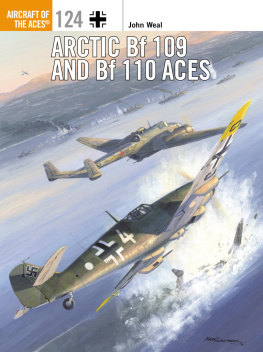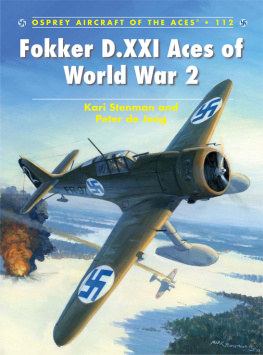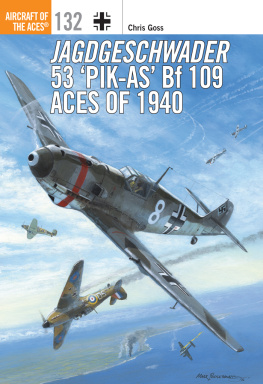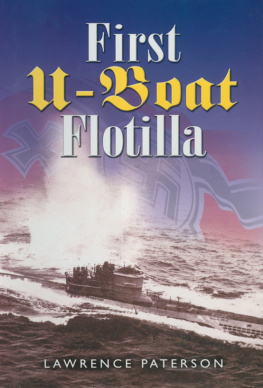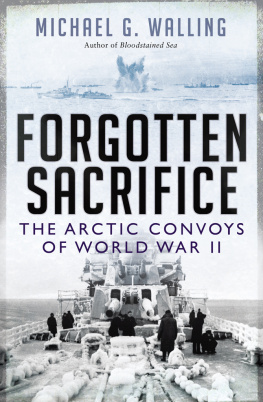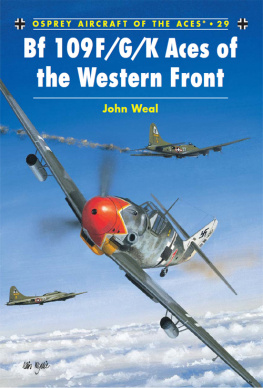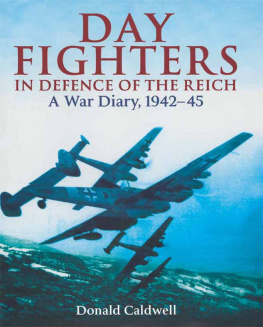
Author
John Weals passion for German aircraft makes this work a treat for students of the subject. He has written eight previous volumes in the Aircraft of the Aces series, as well as Combat Aircraft and Aviation Elite Units titles.
Illustrator
Chris Davey has illustrated more than 30 titles for Ospreys Aircraft of the Aces, Combat Aircraft and Aviation Elite Units series since 1994. Based in Mansfield, Nottinghamshire, he is one of the last traditional airbrush artists in the business.
Front Cover
During the brief midsummer months of 1943 - a period when the Arctic sun never set - the pilots of II. and III./JG 5 fought numerous actions in defence of their own small, but vitally important, coastal supply convoys. With seeming disregard for the losses they were suffering, the Soviets would throw in wave after wave of attack- and torpedo-bombers against these convoys and, as a result, many of JG 5's Arctic Experten found themselves adding significantly to their already impressive tallies.
One such engagement took place late on the evening of 4 July when the Bf 109s of 7. and 8. Staffeln successfully fought off a mixed force of low-flying Il-2s, Pe-2s, Bostons and Hampdens that were attacking an inbound convoy making its way down the west coast of the Rybachiy Peninsula. In the space of less than 20 minutes no fewer than 19 enemy aircraft had been shot down into the sea, six of them being claimed by Leutnant Theo Weissenberger alone.
Recently appointed as Staffelkapitn of 7./JG 5, Weissenberger had already caught and despatched a single Pe-3 reconnaissance aircraft off the northwestern tip of the peninsula some 45 minutes before the main assault began. In the fierce melee that followed, he quickly accounted for a trio of Il-2s (the second of these was the 100th victory of his career) before going after a gaggle off five Hampden torpedo-bombers. The first of these went down almost immediately, but it then took a five-minute chase at wave-top height before the second cartwheeled into the water from a height of just ten metres. Two minutes after that Weissenberger claimed his seventh, and last, victim of the day - an incident vividly captured in Mark Postlethwaite's specially commissioned cover artwork
Title pages
A variation on the winter theme, this heavily mottled Bf 109G-2/R6 'Kanonenboot' ('gunboat' - note the underwing cannon gondolas) is the 'Yellow 3' that 94-victory ace Oberfeldwebel Rudolf Mller was forced to put down on its belly on a frozen lake a few kilometres to the east of Murmansk on 19 April 1943 (via Eddie Nielinger)

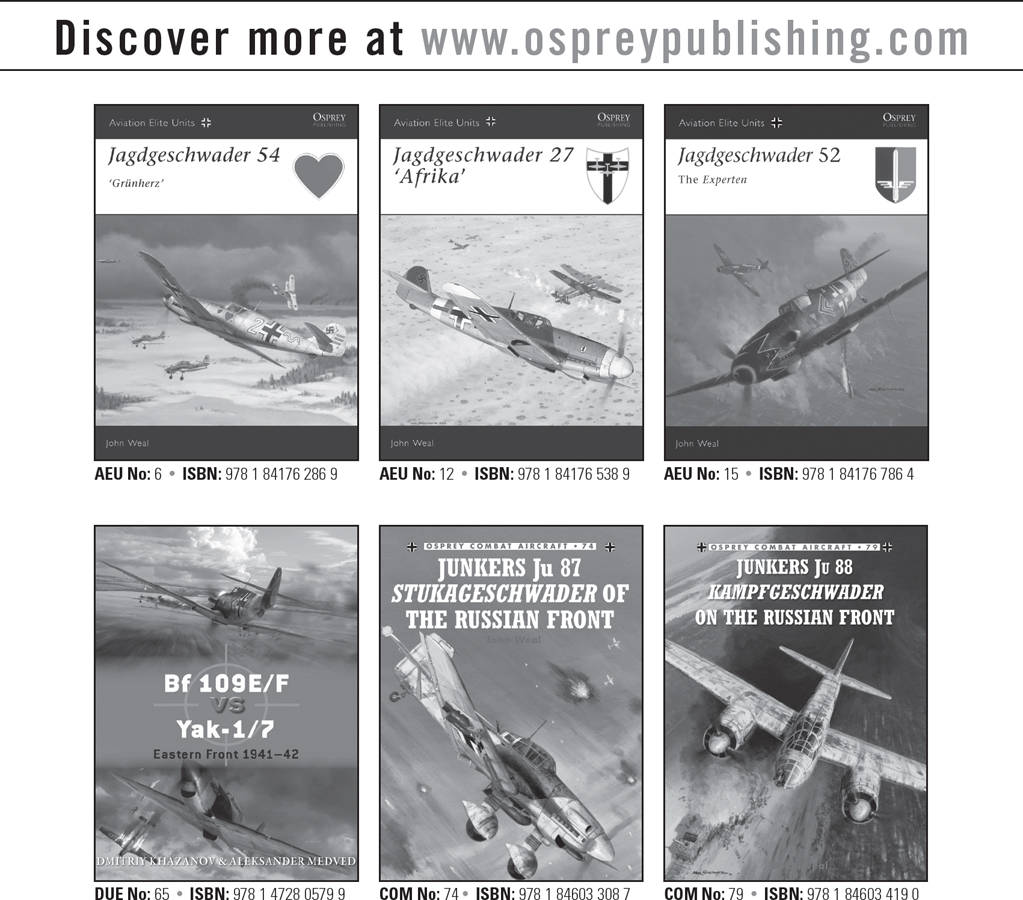
First published in Great Britain in 2016 by Osprey Publishing
PO Box 883, Oxford, OX1 9PL, UK
1385 Broadway, 5th Floor, New York, NY 10018, USA
E-mail:
This electronic edition published in 2016 by Bloomsbury Publishing Plc
Bloomsbury is a registered trademark of Bloomsbury Publishing Plc
Osprey Publishing, part of Bloomsbury Publishing Plc
2016 Osprey Publishing Ltd.
All rights reserved
You may not copy, distribute, transmit, reproduce or otherwise make available this publication (or any part of it) in any form, or by any means (including without limitation electronic, digital, optical, mechanical, photocopying, printing, recording or otherwise), without the prior written permission of the publisher. Any person who does any unauthorised act in relation to this publication may be liable to criminal prosecution and civil claims for damages.
A CIP catalogue record for this book is available from the British Library.
ISBN: 978-1-78200-798-2 (PB)
ISBN: 978-1-78200-800-2 (eBook)
ISBN: 978-1-78200-799-9 (ePDF)
Edited by Tony Holmes
Cover Artwork by Mark Postlethwaite
Aircraft Profiles by Chris Davey
Maps by Bounford.com
Osprey Publishing supports the Woodland Trust, the UKs leading woodland conservation charity. Between 2014 and 2018 our donations will be spent on their Centenary Woods project in the UK.
www.ospreypublishing.com
To find out more about our authors and books visit www.ospreypublishing.com. Here you will find our full range of publications, as well as exclusive online content, details of forthcoming events and the option to sign up for our newsletters. You can also sign up for Osprey membership, which entitles you to a discount on purchases made through the Osprey site and access to our extensive online image archive.
CHAPTER ONE
1941 THE OPENING MONTHS
M uch has been written about Germanys invasion of Russia on 22 June 1941. This is not altogether surprising given the fact that, as Hitler himself had boasted, Operation Barbarossa would be the greatest military operation of all time. The Fhrer of the Third Reich was to hurl very nearly three million men, some 3500 tanks, more than 7000 artillery pieces, 600,000 motor vehicles, almost three-quarters of a million horses and nearly 2000 aircraft into his ultimately ill-fated assault on fellow dictator Josef Stalin, claiming that The world will hold its breath and fall silent when Barbarossa is mounted.

Bisected by the River Litsa, the 100 kilometres of coastal tundra that separated Petsamo from Murmansk formed the inhospitable backdrop against which much of the Luftwaffes 40-month Arctic war against the Soviets was fought
The world may have held its breath, but it was far from silent. News headlines around the globe screamed word of the Wehrmachts initial successes as Hitlers armed might smashed through the Soviet Unions frontier defences. Yet amidst all the opening thunder and furore, there was one tiny part of Barbarossa that was and remains to this day almost entirely overlooked. Far above the Arctic Circle, separated from the main fighting fronts by more than a thousand kilometres of near featureless Finnish forest, small opposing bands of German and Soviet forces were locked in a self-contained, almost private war of their own.
The bulk of the relatively few German troops that were in the far north was made up of two mountain divisions under the overall command of General Eduard Dietl, the Hero of Narvik, who had been the first member of the Wehrmacht to be awarded the prestigious Oak Leaves to the Knights Cross (thereby beating the Luftwaffe fighter pilot duo Werner Mlders and Adolf Galland into second and third places, respectively, by just over two months).
Dietl was briefed personally by Hitler on the role his mountain corps was to play on the Arctic Ocean front. Its first task, he was told, was to secure the mineral-rich regions around Petsamo, in northern Finland, currently held by the Russians, and then to advance the laughable 100 kilometres Hitlers own words eastwards to capture Murmansk, the Soviet Unions only Arctic port that was ice-free all year round.
On 29 June 1941, exactly one week after the start of Barbarossa, during which time they had already taken Petsamo, Dietls troops crossed the erstwhile FinnishRussian border. But those laughable 100 kilometres of barren tundra defeated them. The Wehrmachts mountain specialists, who had been instrumental in conquering and occupying the whole of Norway in less than nine weeks just a year earlier, failed to reach Murmansk. They, and the Soviet units that had stubbornly barred their progress, then drew breath and began to dig in under the wan light of the midnight sun. For both sides it was the start of more than three years of static trench warfare warfare more reminiscent of Flanders in 1914-18 than modern

